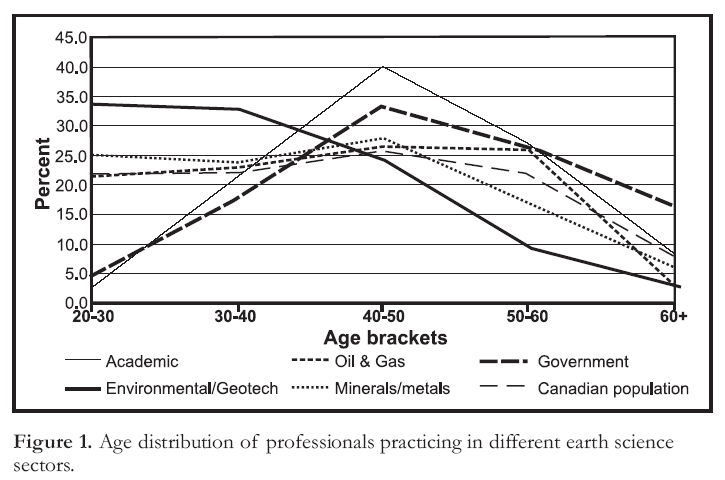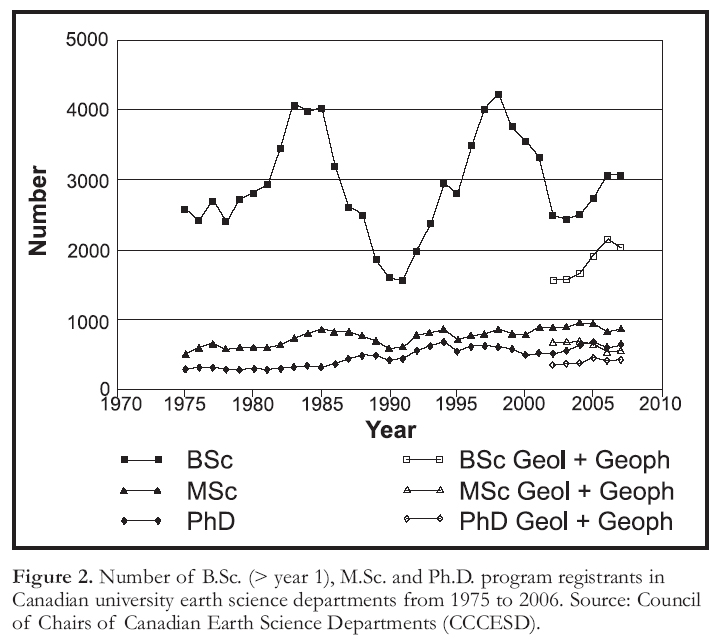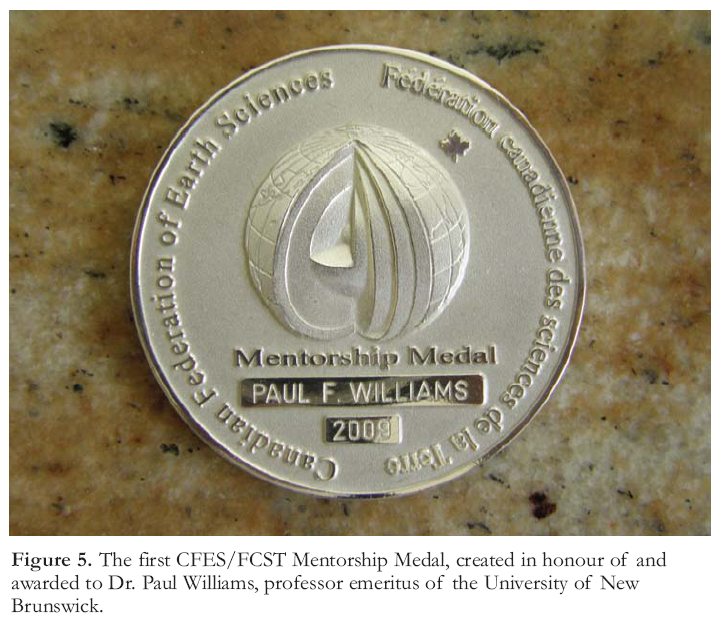Series
Issues in Canadian Geoscience.
The Canadian Federation of Earth Sciences / Fédération Canadienne des Sciences de la Terre: 2008 Highlights
Elisabeth KostersManaging Director, Canadian Federation of Earth Sciences, 210 Main Street Wolfville, NS, Canada, B4P 1C4
ekosters_cfes@magma.ca
SUMMARY
The Canadian Geoscience Council (CGC) was reorganized into the Canadian Federation of Earth Sciences/ Fédération Canadienne des Sciences de la Terre (CFES/FCST) in the fall of 2006. This article highlights the activities of the new organization in 2008, the first year that real progress and renewal could be demonstrated. The organization aims to be the unified voice of earth science in Canada, using a multi-pronged approach along three lines: defragmentation of the Earth Science sector, outreach (to K-12 and the general public) and lobbying (to decision makers). We also published a Human Resources snapshot of our sector and are making progress toward creating one Canadian Geoscience Literature database.RÉSUMÉ
La Fédération canadienne des sciences de la Terre (FCST), jadis le Canadian Geoscience Council en anglais a été réorganisé à l’automne 2006 et se présente dorénavant sous les appellations de Canadian Federation of Earth Sciences / Fédération canadienne des Sciences de la Terre (CFES/FCST). L’article qui suit souligne les principales activités du nouvel organisme en 2008, une première année de véritable progrès et de renouvellement de la participation. Cet organisme entend être « la » voix des géosciences au Canada en concentrant ses efforts en trois directions, soit : la défragmentation du secteur sciences de la Terre, la sensibilisation (niveau fin secondaire et grand public), le lobbyism (influence auprès des instances décisionnelles). Nous avons aussi publié un instantané des ressources humaines du secteur et progressons dans l’établissement d’une base de données de la littérature géoscientifique canadienne.INTRODUCTION
1 The Canadian Federation of Earth Sciences/Fédération canadienne des sciences de la Terre [CFES/FCST; www.geoscience.ca] is the new constellation of earth science organizations that replaced the Canadian Geoscience Council (CGC) in the fall of 2006. A short summary for those of you who are not aware of this history: the CGC was created in 1971 as an umbrella organization for Canadian Geoscience. Despite considerable effort and success, CGC’s effectiveness decreased over the last decade. Several member societies withdrew from CGC, causing different sectors of our profession to become increasingly isolated from each other.
2 The 21st century demanded renewal, and this realization resulted in reorganizing and renaming CGC in 2006. The new organization, CFES/ FCST, charges its constituent associations an annual fee of $2 per member (minimum of $500 total) and has a professional managing director rather than a volunteer, whereas most CGC finances were covered by generous grants from Natural Resources Canada. Fortunately, member organizations1have expressed a lot of trust in this renewed venture and have joined CFES/FCST without hesitation. There are now twelve paying member organizations and we thank them for their continued support, both financially and otherwise.
3 The mandate and vision of CFES/FCST is to be the unified voice for earth science in Canada through initiation and support of activities that supersede those of individual member societies. Activities roughly divide along three lines:
- Lobbying;
- ‘Defragmentation’ of Canadian earth science; and
- Geoscience outreach.
PEOPLE
4 The CFES/FCST has a seven-person Board of Directors. The CFES/FCST president serves 2 years, and 2008 was Ian Young’s last year as the first president of the new organization. Ian (Encana, Calgary) brought in fresh ideas and an immense amount of energy, and this was certainly key to making the (re)start of CFES/FCST successful. Ian stays on as past-president through 2009. In October 2008, he was succeeded by Bill Mercer of Toronto, who is an independent mineral exploration geologist and a past-president of PDAC. Bill brings a very different background to CFES/FCST, and his long experience in the Arctic gives us many new and needed insights from which the organization will benefit.
5 Also in 2008, we said goodbye to our dedicated international director Bryan Schreiner and welcomed in his place Peter Bobrowsky, who is with the GSC in Ottawa. Peter is also the Secretary General of the International Union of Geosciences (IUGS), one of 30 unions under the UN umbrella of the International Council of Science (ICSU), and is therefore very valuable to Canada and to CFES/FCST. Our treasurer, James Burns, stepped down and we were happy to find a replacement for this important, but difficult, and hence unpopular task in the person of Pat Ryall, who is at Dalhousie University’s Earth Science Department in Halifax.
6 Fran Haidl remained our out-reach director in 2008, but has recently been replaced by Godfrey Nowlan, the incoming president of the Canadian Geoscience Education Network. With 300 members and growing Fran works for the Saskatchewan provincial government in Regina and has immense experience in outreach. She also serves as president of the Canadian Geo-science Education Network (CGEN); with 270 members and growing, CGEN is a subcommittee of CFES/FCST, and its president serves as a CFES/FCST director. The remaining directors are Jeff Packard, CFES/FCST’s communication director, and Steve Holysh. Jeff, who works for Talisman Energy Inc. in Calgary, is a past-president of CSPG, serves on GAC Council and is one of those who were instrumental in transforming the CGC into CFES/FCST. Steve Holysh is Senior Hydrogeologist at the Conservation Authorities Moraine Coalition, based in Downsview, ON, and is a past-president of the National Chapter of the International Association of Hydrogeologists (CNCIAH).
7 Although CFES/FCST is formally based in Calgary, the actual hub is in Wolfville, Nova Scotia, where Elisabeth Kosters does the day-to-day management from her home office on the Minas Basin. Elisabeth brings 25 years of international earth science experience in government and academia to the job and enjoys all aspects of the CFES/FCST managing director-ship. Administrative assistant Catherine Barrett, based in Calgary, played a key role in the collection and manipulation of data from the Human Resources Survey (see following section) and otherwise provides invaluable back-up help.
HUMAN RESOURCES SURVEY
8 A project that does not concern the three main issues listed in the Introduction, but was likely one of the most important in 2008, was a human resources survey, Human Resources Needs in Earth Science in Canada [http://www.geoscience.ca/CFES_HR_requirements_Canadian_earth_sciences.pdf]. By the time this article is published, some of you will have seen discussions of this subject in The Reservoir, The Recorder or the AAPG Explorer. The survey, the first of its kind in Canada, warned of impending, across-the-board labour shortages in the earth science professions. We are greying fast everywhere except in the environmental/geotechnical sectors. This is worrisome, as most sectors expect to grow significantly in the next 5 years (although we note here that the survey was done prior to the start of the economic downturn). The survey also examined work conditions and educational requirements. In addition to publication in Canadian trade magazines, an article discussing the results of the survey will be published in the AAPG Explorer. Some of the important data collected during the survey are illustrated in Figures 1 to 4.
LOBBYING
9 Canada has more landmass than any other country except Russia (and more coastline than any other country) and it has amazingly rich resources and stunningly pristine environments. It has the world’s largest reserves of fresh water and six UNESCO World (Geo)Heritage Sites [http://whc.unesco.org/en/statesparties/ca]. Yet decision makers are largely unaware of these facts and of what this means for our national identity and well-being. Of course, every Member of Parliament will be able to quote something that resembles the first sentence of this paragraph, but it more or less stops there. Confronted with a natural hydrocarbon seep in an outcrop close to his home, one MP asked anxiously “but it isn’t dangerous, is it?” Many readers will have similar experiences. Earth science literacy is poor, at best, and this meagre level of understanding does not benefit policy and decision making. Clearly, there is work to do here, but how can it be done in a concise and convincing manner? A daunting task, and one that we are just beginning to address. The CFES/FCST uses a multi-pronged approach. To get the word out, you must have media attention, but you must also have something intelligent to say. The human resources survey generated important information, and we issued a media release following its completion. When the Prime Minister announced that $100m would be spent on geological mapping to stimulate mineral exploration and economic development in northern communities, we sent him an open letter congratulating him on the wise decision, but also warned him that we may not have enough professional people power to carry out the task [http://www.geoscience.ca/Open_Letter_Prime_Minister_Sept_2008.pdf].
Earth Science Advisory and Advocacy Panel: ‘The Celebrity Approach’
10 Within our wider earth science professional environment are accomplished individuals who have earned wide recognition for their achievements. These achievements vary widely in character, but together such people can have a formidable impact on the public perception of earth science. The CFES/FCST has invited up to six individuals from across our profession (representing heritage, hydrocarbons, earth resources, environment and research and education) to form a panel that will advocate the earth sciences at every possible opportunity. At the time of writing this overview, we are in the final stages of formalizing the panel, and have had great success in attracting our first choice candidates. Watch for an announcement shortly!
Figure 1. Age distribution of professionals practicing in different earth science sectors.Figure 2. Number of B.Sc. (> year 1), M.Sc. and Ph.D. program registrants in Canadian university earth science departments from 1975 to 2006. Source: Council of Chairs of Canadian Earth Science Departments (CCCESD).Position Papers
11 The two most contentious issues currently facing earth scientists on a regular basis are Climate Change and Creationism/Intelligent Design. CFES/FCST published 2 position papers on these issues [http://www.geoscience.ca/pospapers.html] and some web surfing has taught us that they have both been quoted in various locations.
DEFRAGMENTATION
12 All sectors of the Canadian earth science community face common challenges, and member societies have addressed many of these individually over the years. The CFES/FCST is working to facilitate finding nationwide solutions to some of these challenges. Two issues that we worked on last year were Insurance and Student Chapters. In addition, we are working hard, in conjunction with our American counterpart, the American Geological Institute (AGI), to create a Canadian Earth Science Literature Database, CanGeoRef.
CanGeoRef
13 The AGI launched GeoRef in 1966, and more than 40 years later, it is the world’s best and most complete Earth Science Database [http://www.agiweb.org/georef/]. Over the years, GeoRef has expanded from containing mostly American and English language earth science literature to more global references, and it contains not only peer-reviewed articles, but also government reports and university theses. There are presently over 3 million references in GeoRef.
14 Around 2002, AGI initiated a cooperative venture with Geoscience Australia (the equivalent of the GSC) to create AusGeoRef, a subset of GeoRef. The customized AusGeoRef is now available at a lower price than the larger GeoRef, thus making it more attractive for smaller companies to buy a license.
15 The GeoRef currently contains about 150 000 Canadian earth science references. These include all literature produced by NRCan, a few provincial references, some Canadian university theses, and a fairly complete set of articles published in peer-reviewed journals. It is estimated that an additional 150 000 references, many of them from provincial publications, are missing from GeoRef, and that at least 3000 new references can be added annually.
Figure 3. Expected net change in employment over the next five years among various earth science sectors. It should be noted that the survey was completed in the late spring of 2008, before the present economic downturn.
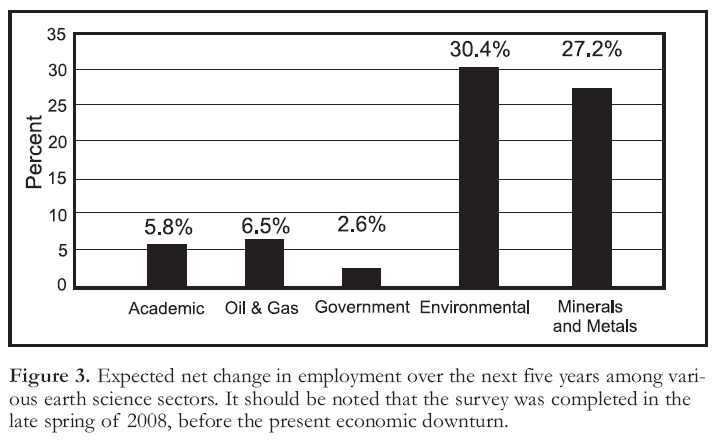
Display large image of Figure 3
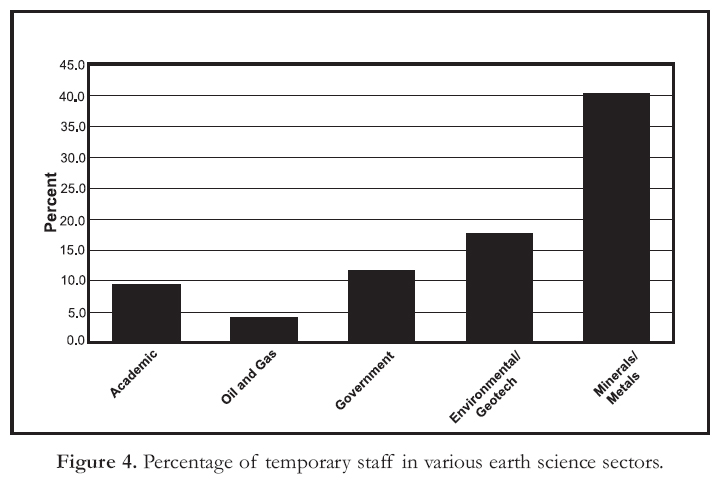
Display large image of Figure 4
16 The AGI has asked CFES/FCST to partner with them in developing CanGeoRef, a Canadian earth science literature subset. New entries will be part of GeoRef, but CanGeoRef itself will be available as a separate subset at a much lower price than GeoRef, thus making it attractive to a much larger market that includes smaller companies and other user groups seeking only Canadian geo-science literature. Hence, more Canadian earth science literature would be easily accessible to everyone. At the time of writing this article, CFES/FCST is still researching the issue together with the provincial geological surveys and AGI, but we believe that the chances are very good that we can offer this high-quality product to the Canadian earth science community at a competitive price in the near future.
Insurance
17 In 2007 and 2008, the PDAC negotiated a very competitive insurance package for independent consultants and small consultancies in the minerals industry. In 2008, CFES/FCST brought together representatives from member societies together with the insurance broker to explore the possibility of opening this opportunity up to sectors. These meetings were very constructive and the discussion expanded to explore better insurance packages for member societies themselves. The result is positive and the final touches are being worked on; look for an announcement on the web-site of your member society! This is where it pays off to be a member of a CFES/FCST constituent society, because the policies will be available only to those members.
Student Chapters
18 Canada has more than 20 degree-granting university programs in earth sciences, and technical societies are all eager to reach out to these students. A few years ago, GAC and PDAC merged their student chapters into the Logan Student Chapters [http://www.gac.ca/students/], a big step forward because it is challenging for student clubs of smaller university departments to manage affiliation with more than one technical or professional society. Among other member societies, CSPG also has a sizeable student chapter program [http://www.cspg.org/students/students-outreach-chapters.cfm]. During 2008, CFES/FCST facilitated discussions between GAC, PDAC and CSPG to explore the possibility of merging the CSPG student chapters with the Logan student chapters. While this merger has as yet not been completed, the issue is close to being resolved and all parties hope that the academic year 2009-2010 will see a merger of the respective chapters. Once the newly merged chapters have functioned for a year or two, we plan to invite other societies to join, so that eventually, we will have one national student chapter program, representative of all technical societies. However, individual societies will continue to offer their own student awards and other student programs, such as CSPG’s Student–Industry Field Trip and PDAC’s Student–Industry Mineral Exploration Workshop. Joining forces in this way is especially important because both the American Association of Petroleum Geologists and the Society of Economic Geologists are opening offices in Canada and are approaching students with attractive student chapters. While we welcome the interest of other societies in the Canadian earth science community, we think that it is of paramount importance not to lose students to non-Canadian student chapters.
Gussow–Nuna Conference
19 The CFES/FCST was one of the driving forces behind, and co-sponsor of, the Geoscience of Climate Change Gussow–Nuna Conference, held last October at the Banff Centre in Alberta. The conference was organized by member societies CSPG and GAC as a combined Gussow–Nuna Conference, and chaired by Dr. Andrew Miall of the University of Toronto. Andrew convened a stellar international group of speakers around a well-balanced program that addressed the fundamental scientific questions of long- and short-term climate change, mankind as a geologic factor, and the relationship between climate change and declining global hydrocarbon reserves. Those who missed the conference can view the presentations at [http://www.cspg.org/conventions/abstracts/2008abstracts_gussow.htm].
OUTREACH
20 During 2008, the central year of the three-year International Year of Planet Earth (IYPE), outreach was of foremost importance to the CFES/FCST. The website of the Canadian National Committee (CNC) for IYPE introduces the viewer to the three main Canadian IYPE activities: i) the WHERE Challenge; ii) the upcoming book on the geology of Canada, Four Billion Years and Counting; and iii) the Careers in Earth Sciences website. Although the CFES/FCST was not the main driver for these activities, we were sufficiently involved to warrant a short overview of each of these initiatives. Soon after its formation, the CNC of IYPE decided to focus its activities on outreach, under the thematic acronym WHERE (Water, Hazards, Energy, Resources, Environment). Ian Young, as CFES/FCST president, serves on the CNC-IYPE, as does Godfrey Nowlan, in his role as as president of CGEN. The CNC-IYPE website [www.earthsciencescanada.com] will eventually become the website of the CFES/FCST, hence close cooperation is necessary.
Careers in Earth Sciences Website
21 The ‘Earth Science Careers’ website [www.earthsciencescanada.com/careers/] was launched in the fall of 2008. It was initiated by CGEN and has been incubating for a few years, as ideas developed for a site to educate, excite and encourage youth to consider a career in the earth sciences. The site is designed as a treasure map and takes students through the questions ‘What is it?’, ‘What do I need?’, ‘What can I be?’ (answers appear in the form of an exhaustive alphabetical list of careers), ‘Where can I learn?’, ‘How much can I make?’ and ‘What is it like?’ component. Many Canadian earth scientists volunteered their experiences as content for the what is it like component. Check out this site – you may find one of your colleagues or friends there!
‘WHERE’ Challenge
22 What on Earth is in your Stuff and Where on Earth does it come from? Even many professionals are not consciously aware of the answer to that question for much of our ‘stuff’. From cell phones to LCD screens, the cooling element in the fridge, the light but strong frame of that new bicycle, and of course the chips in the now ubiquitous ipod, Earth materials are, well... elemental. And yet society takes these things for granted. The ‘Where Challenge’ [www.earthsciencescanada.com/where/] aims to inform youth up to the age of 14, and fill in this knowledge gap. The contest deadline was in early March; prizes will be awarded regionally as well as nationally and were made possible thanks to generous donations. CFES/FCST hopes to entice enough sponsors to be able to make this an annual contest under the leadership of CGEN. One year is obviously not enough for such an important issue.
Four Billion Years and Counting: Canada’s Geological Heritage
23 In 2001, the Atlantic Geoscience Society published The Last Billion Years, a Geological History of the Maritime Provinces of Canada. The book became a Canadian non-fiction bestseller in that same year and is now entering its fourth printing. Inspired by this success, its editors, Rob Fensome and Graham Williams of GSC Atlantic, set out to produce a book modelled along similar lines but with a much-expanded focus – the Geology of Canada [http://cfesfcst.ca/fby/]. This project has become one of the CNC-IYPE outreach projects, thus enabling it to attract sponsorship. The CFES/FCST will be the copyright holder for this book, which is expected to be published in late 2009.
Outreach Liaison Committee
24 As with student chapters, all technical societies are active in outreach to the general public. Outreach directors generally have considerable experience and brim with creative ideas; however, they usually do not have time to communicate extensively with each other. The CFES/FCST therefore created the ‘outreach liaison’ committee, in which the outreach directors of its member societies participate via teleconference every three months; we sometimes have as many as 15 people on the phone. The goal is to share ideas, and the lively discussions and positive feedback tell us that we are providing a welcome service.
OTHER
25 And last but not least, we were approached with a very well conceived proposal to generate a mentorship award. After lively discussions, we concluded that this is an extremely important, and often overlooked, aspect of everyone’s working life, independent of sector or level of education of mentor or mentee. A subcommittee was formed and the first mentorship award was presented during the 2009 Joint Assembly in Toronto. The first recipient will be Dr. Paul Williams, Emeritus Professor of Structural Geology at the University of New Brunswick in Fredericton (Fig. 5).
CONCLUSION
26 If you did not know what CFES/FCST is or does, we hope that you have found this article informative. Most of the work is carried out by volunteers, either by our directors or by people who are generously donating their time on subcommittees. We also benefit immensely, twice a year, from round table discussions with representatives from our member societies and from our observer organizations: the Canadian Council of Professional Geologists, Natural Resources Canada, the Committee of Provincial Geologists, the Alliance of Natural History Museums of Canada, and the Canadian Association of Science Centres. This year, we will also welcome the Canadian Geological Foundation and the Partnership Group for Science and Engineering as observer organizations. We can only serve as the unified voice of Canadian Earth Science by communicating intensively with our constituents so that our actions are truly a joint effort. There is much work to be done, but we feel that we are moving in the right direction. Please join us and be part of the future of Geo-science in Canada!
Figure 5. The first CFES/FCST Mentorship Medal, created in honour of and awarded to Dr. Paul Williams, professor emeritus of the University of New Brunswick.